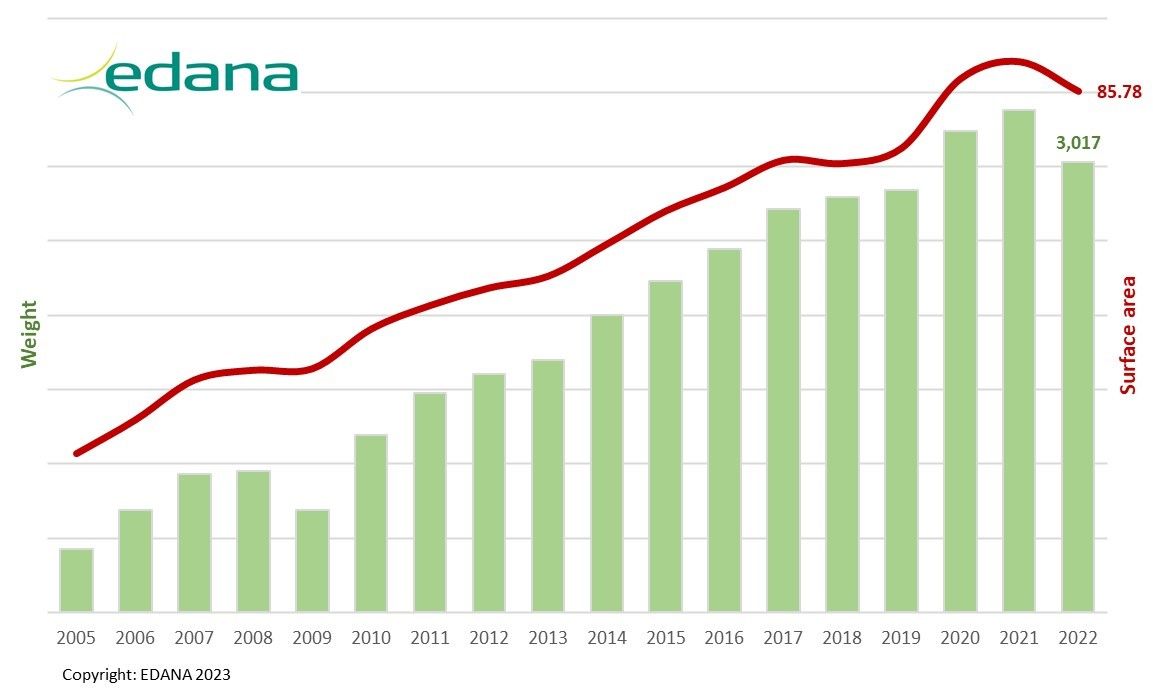EDANA has released an overview of the high-level figures from its statistics report on nonwovens’ production and deliveries for 2022. The figures, while lower than during COVID-19, have returned to pre-pandemic levels and we can again see a steady growth trend despite the economic and energy crisis, and the war in Europe.
Nonwovens’ production in Greater Europe has returned to pre-pandemic levels despite the challenges posed by the economic and energy crisis and the ongoing war in Europe.
It’s also positive to note that there has been steady growth in this industry, with a 3.3 per cent increase in volume and a 9.1 per cent increase in surface area compared to data from 2019.
In 2022, compared to data from 2019, nonwovens production in Greater Europe increased by 3.3 per cent to reach 3,017,085 tonnes and by 9.1 per cent in surface area resulting in 85.8 billion square metres of nonwovens being manufactured, the report revealed.
“This conclusion can be refined according to the different production processes. Some processes, such as drylaid-hydroentangled and air-through bonding, recorded an even higher output in 2022 than in 2021. While, the production of other fibre-based materials, including drylaid, wetlaid, and airlaid technologies, were below the levels observed three years earlier. The production of spunmelt nonwovens was down again after peaking in 2021, but the 2022 output was still 8.1 per cent over its 2019 level,” Jacques Prigneaux, EDANA’s market analysis and economic affairs director, further expanded on the data.
Similar conclusions can be drawn from the end-use perspective. Nonwovens market segments such as hygiene, medical, building construction, filtration, electronic materials, and wipes, which were almost flat or had significantly decreased compared with their 2021 levels, were still well over figures observed in 2019. There were some exceptions in other durables applications, where nonwovens sales were still below 2019 levels: automotive interiors (-27.8 per cent), agriculture (-13.1 per cent), and civil engineering (-4.6 per cent). In 2022, the most notable increase was in table linen applications, which exceeded both 2019 and 2021 levels.

The source data was supplied by EDANA’s member companies and compiled by Prigneaux. “When a company becomes an EDANA member, they are asked to reply to a questionnaire about their business which gathers data on their sales by market segment, and on their consumption of raw materials and production by technology. We collect data in both tonnage and square metres,” explained Prigneaux. This is extremely valuable as it helps EDANA and its members to follow the evolution of the grammage of different products both by technology and by market segment.
The questionnaire that EDANA’s nonwovens producing members receive is very wide and assesses many elements including CO2 emissions, and new for 2022, energy consumption. The exhaustive excel document and report comprising all the data is available free of charge for those members that took part in the exercise, and is a valuable business tool for EDANA and its members.
A summary report – 2022 European Nonwovens Markets Insights – is also available for EDANA’s other members. Prigneaux will share an overview of the key findings during the Continental briefings at the EDANA stand during Index 2023.
Index23, is the largest global meeting place for players in the nonwovens industry. The Continental Briefings consist of a series of presentations given by experts from key associations around the world. Taking place across the week they provide visitors with industry updates for all the key nonwoven production areas. Each briefing will also include an introduction and commentary from Prigneaux, as he provides a trade and trends analysis for that particular geography from a European perspective.
The programme for the upcoming conference is as follows. On Tuesday, April 18, Li Guimei, president of CNITA (China Nonwovens and Industrial Textiles Association), will present an overview and discuss the green development of China’s nonwovens industry. The presentation will cover the production, investment, import and export, and end-use of China’s nonwovens in 2022, as well as the status of green development. Additionally, the presentation will analyse the opportunities and challenges and forecast the future development of China’s nonwovens industry.
On Wednesday, April 19, Mark Snider, chief market and industry analyst at INDA (Association of the Nonwoven Fabrics Industry), will discuss nonwovens industry trends in North America and INDA’s vision for the future. The presentation will focus on new horizons, nonwovens trends in North America, regional hotspots, and INDA’s vision for the future.
On Thursday, April 20, Kazuaki Baba, secretary general of ANFA (Asia Nonwoven Fabrics Association), will present on Asia’s nonwovens production trends.
Fibre2Fashion News Desk (RR)



:max_bytes(150000):strip_icc()/Health-milk-recall-462d75ddea10415986c38d8da42d5f09.png)

